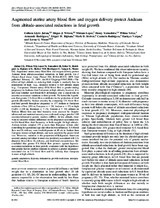Mostrar el registro sencillo del ítem
Augmented uterine artery blood flow and oxygen delivery protect andeans from altitude-associated reductions in fetal growth
| dc.contributor.author | Julian, Colleen Glyde | |
| dc.contributor.author | Wilson, Megan J | |
| dc.contributor.author | López, Miriam | |
| dc.contributor.author | Yamashiro, Henry | |
| dc.contributor.author | Téllez, Wilma | |
| dc.contributor.author | Rodríguez, Armando | |
| dc.contributor.author | Bigham, Abigail W | |
| dc.contributor.author | Shriver, Mark D | |
| dc.contributor.author | Rodríguez, Carmelo | |
| dc.contributor.author | Vargas, Enrique | |
| dc.contributor.author | Moore, Lorna G | |
| dc.date.accessioned | 2016-10-04T14:49:15Z | |
| dc.date.available | 2016-10-04T14:49:15Z | |
| dc.date.issued | 2009-02-20 | |
| dc.identifier.uri | http://repositorio.umsa.bo/xmlui/handle/123456789/8151 | |
| dc.description.abstract | Abstract. The effect of high altitude on reducing birth weight is markedly less in populations of high- (e.g., Andeans) relative to low-altitude origin (e.g., Europeans). Uterine artery (UA) blood flow is greater during pregnancy in Andeans than Europeans at high altitude; however, it is not clear whether such blood flow differences play a causal role in ancestry-associated variations in fetal growth. We tested the hypothesis that greater UA blood flow contributes to the protection of fetal growth afforded by Andean ancestry by comparing UA blood flow and fetal growth throughout pregnancy in 137 Andean or European residents of low (400 m; European n 28, Andean n 23) or high (3,100–4,100 m; European n 51, Andean n 35) altitude in Bolivia. Blood flow and fetal biometry were assessed by Doppler ultrasound, and maternal ancestry was confirmed, using a panel of 100 ancestry-informative genetic markers (AIMs). At low altitude, there were no ancestry-related differences in the pregnancy-associated rise in UA blood flow, fetal biometry, or birth weight. At high altitude, Andean infants weighed 253 g more than European infants after controlling for gestational age and other known influences. UA blood flow and O2 delivery were twofold greater at 20 wk in Andean than European women at high altitude, and were paralleled by greater fetal size. Moreover, variation in the proportion of Indigenous American ancestry among individual women was positively associated with UA diameter, blood flow, O2 delivery, and fetal head circumference. We concluded that greater UA blood flow protects against hypoxiaassociated reductions in fetal growth, consistent with the hypothesis that genetic factors enabled Andeans to achieve a greater pregnancyassociated rise in UA blood flow and O2 delivery than European women at high altitude. | es_ES |
| dc.language.iso | en | es_ES |
| dc.publisher | Am J Physiol Regul Integr Comp Physiol | es_ES |
| dc.subject | ADAPTACIÓN GENÉTICA | es_ES |
| dc.subject | HIPOXIA | es_ES |
| dc.subject | RESTRICCIÓN CRECIMIENTO INTRAUTERINO | es_ES |
| dc.subject | FLUJO DE SANGRE UTEROPLACENTAL | es_ES |
| dc.title | Augmented uterine artery blood flow and oxygen delivery protect andeans from altitude-associated reductions in fetal growth | es_ES |
| dc.type | Article | es_ES |

